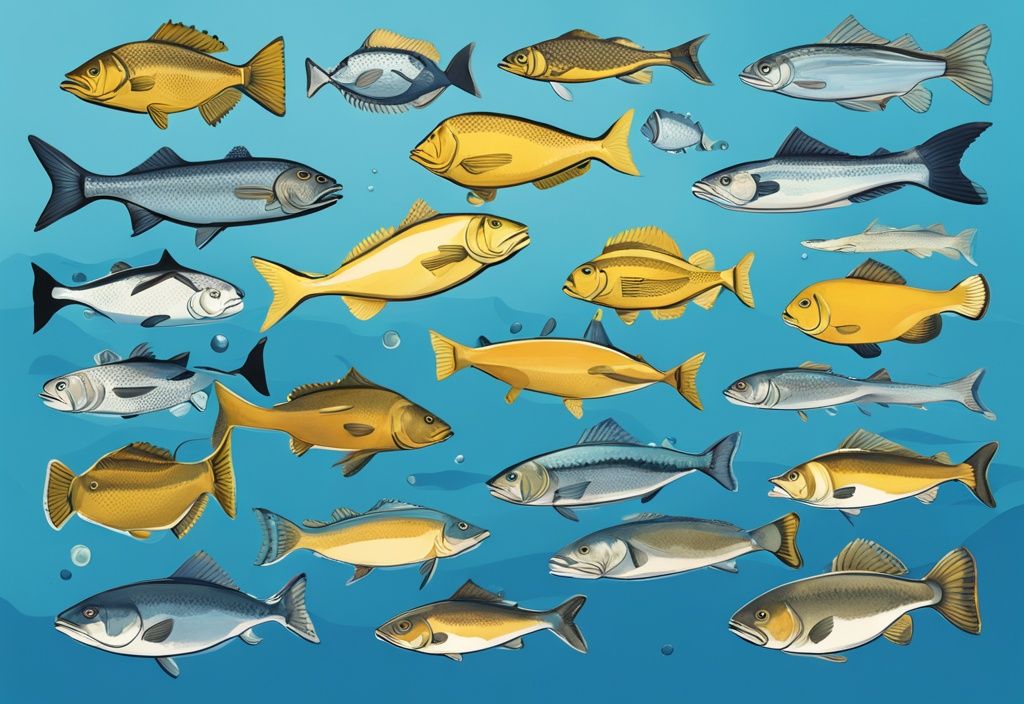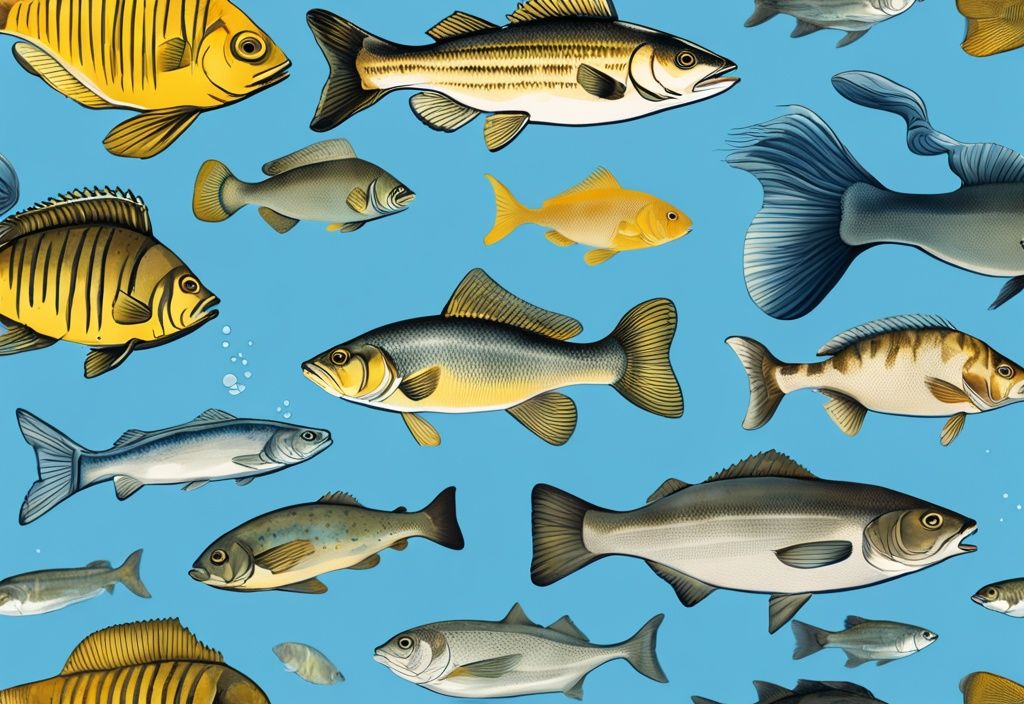Hey there, fellow fishing enthusiasts! Did you know that Lake Michigan, one of the largest freshwater lakes in the world, is home to over 80 different fish species? Picture this: casting your line into these vast waters, where adventure and tranquility meet. Lake Michigan’s sprawling beauty stretches across four U.S. states, offering a rich tapestry of fishing traditions. Its waters are alive with a mix of native, introduced, and invasive species, each adding a unique twist to the lake’s ecosystem. From the majestic Lake Trout to the feisty Smallmouth Bass, the diversity here is nothing short of astounding. Ready to dive in? Let’s explore the fascinating world beneath the surface together!
Native Fish Species in Lake Michigan
Lake Michigan is a treasure trove of diverse fish species, each adding its own unique flavor to the aquatic tapestry. From the mighty Lake Trout to the humble Yellow Perch, these fish not only support the lake’s ecosystem but also offer thrilling experiences for anglers of all levels. Let’s dive into the fascinating world of Lake Michigan’s native fish.
Lake Trout
Ah, the Lake Trout, or as we anglers like to call it, the “Mackinaw.” These giants of the Great Lakes, scientifically known as Salvelinus namaycush, are the stuff of legends. Imagine reeling in a Wisconsin state record of 47 pounds—now that’s a story to tell! These deep-water dwellers prefer the chilly, secluded parts of Lake Michigan, where they reign as apex predators. Their role? Keeping the ecosystem in check by munching on smaller fish species. It’s all about balance, right?

Whitefish
Whitefish are the unsung heroes of Lake Michigan’s waters. With their mild flavor and flaky texture, they’re a staple in the culinary world. But there’s more to them than just being a tasty dish. They thrive in the lake’s cold depths, playing a crucial role in maintaining ecological balance. By feeding on smaller fish and invertebrates, Whitefish help keep the ecosystem ticking along smoothly. Their impact is both economic and ecological, making them a cornerstone of Lake Michigan’s fishing industry.
Cisco (Lake Herring)
Cisco, or Lake Herring, might be small and silvery, but don’t let their size fool you. They’re a vital part of Lake Michigan’s food web, serving as the main course for larger predators like Lake Trout. Sadly, these little guys have had a rough time due to overfishing and environmental changes. But fear not—conservation efforts are underway to bring them back to their former glory. It’s all about restoring balance and keeping the biodiversity of Lake Michigan alive and well.
Walleye
Walleye are the rock stars of Lake Michigan, especially for those who love a good fishing challenge. Known for their sharp teeth and keen vision, these predators are best caught during those magical low-light hours. Thanks to stocking programs, Walleye populations are thriving, ensuring they remain a highlight of the lake’s fishing scene. Whether you’re after a delicious meal or an exciting catch, Walleye offer both, adding to the lake’s ecological diversity.
Yellow Perch
Yellow Perch are like the friendly neighbors of Lake Michigan—always around and ready to make your fishing trip a success. They’re abundant and easy to catch, making them a favorite among anglers. Whether you’re fishing in shallow waters or venturing deeper, these tasty fish are accessible and fun to reel in. As part of the food web, Yellow Perch play a key role in maintaining ecological balance by feeding on insects and small fish. Their popularity and presence underscore their importance in Lake Michigan’s vibrant aquatic community.
Introduced Fish Species in Lake Michigan
Chinook Salmon (King Salmon)
Picture this: you’re out on Lake Michigan, the sun warming your back, and suddenly, your line tugs with the force of a freight train. That’s the thrill of hooking a Chinook Salmon, or as we like to call them, “King Salmon.” These giants, known scientifically as Oncorhynchus tschawytscha, were introduced in the 1960s to tackle the pesky Alewife invasion. But they did more than that—they became the crown jewel of the lake’s fishing scene. With a Wisconsin state record of 44 lbs 15 oz, these fish aren’t just a catch; they’re a badge of honor for any angler. Ever tried wrestling one of these beasts? It’s a challenge that keeps you coming back for more.
Coho Salmon (Silver Salmon)
Now, if you’re after a fish with a bit of flair, the Coho Salmon, or “Silver Salmon,” is your guy. Known by the scientific name Oncorhynchus kisutch, these beauties light up the lake in spring and fall. They were brought in to spice up the fishing menu, and boy, did they deliver! With a Wisconsin state record of 26 lbs 1.9 oz, Coho Salmon are not just a catch—they’re a feast. Their presence in Lake Michigan has added a whole new dimension to the fishing culture, offering both recreational joy and commercial value. Have you ever tasted one fresh off the grill? Pure bliss.
Rainbow Trout (Steelhead)
Let’s talk about the acrobats of the lake—Steelhead, the migratory form of Rainbow Trout. These fish are the ultimate performers, leaping and twisting in the air, giving anglers a run for their money. With a Wisconsin state record of 27 lbs 2 oz, Steelhead are a prized catch, and their migratory habits mean you can chase them year-round. They dart between the lake and its tributaries, keeping the fishing scene dynamic and exciting. Ever felt the thrill of battling a Steelhead? It’s an experience you won’t forget.
Brown Trout
Brown Trout, or Salmo trutta, are the wily veterans of Lake Michigan. Known for their cunning and elusive nature, catching one is like solving a puzzle. They were introduced to add a layer of complexity to the fishing scene, and they did just that. With a Wisconsin state record of 41 lbs 8 oz, these fish demand respect and patience. Have you ever matched wits with a Brown Trout? It’s a game of strategy and skill.

Brook Trout
Last but not least, we have the Brook Trout, Salvelinus fontinalis, the jewel of the cooler, deeper waters. These vibrant, smaller fish are a fly fisher’s dream, offering a splash of color and challenge. Supported by stocking programs, they maintain a steady presence in Lake Michigan, enhancing its biodiversity. With a Wisconsin state record of 10 lbs 1 oz, Brook Trout are a testament to the art of fishing. Ever tried fly fishing for Brookies? It’s a dance of precision and patience.
Invasive Fish Species in Lake Michigan
Lake Michigan is a vast aquatic playground, teeming with life. But not all its residents are welcome guests. Some species have muscled their way in, creating ripples in the ecosystem that are hard to ignore. Let’s dive into the stories of these invaders and see how they’re shaking things up.
Alewife
Picture this: a shimmering school of Alewives, small and silver, darting through the waters of Lake Michigan. These little guys made quite the splash back in the mid-20th century. Their numbers skyrocketed, throwing the lake’s ecosystem off balance. If you’re wondering why your fishing line might keep getting tangled when dealing with these fish, check out our guide on why does my fishing line keep getting tangled. To tackle this, predatory fish like salmon and trout were introduced, hoping to reel in the Alewife population. Yet, keeping their numbers in check is still a big task. It’s like trying to juggle fish while riding a unicycle—tricky, but necessary to keep the lake’s harmony.
Round Goby
Now, let’s talk about the Round Goby. These bottom-dwellers are as feisty as they come, spreading fast across Lake Michigan. They’re like the uninvited guests at a party, competing with native species and hogging resources. Their appetite for the eggs and young of native fish is particularly concerning, putting local populations at risk. Managing these aggressive little critters is crucial to safeguarding the lake’s biodiversity. It’s a battle of wits and will, with strategies in place to curb their spread and protect the native aquatic life.
Quagga Mussel
Enter the Quagga Mussel, a bivalve that’s made itself right at home in Lake Michigan. These mussels are like nature’s vacuum cleaners, filtering water and altering the lake’s nutrient dynamics. Sure, the water might look clearer, but it’s a double-edged sword. The food web gets a shake-up, leaving less for other aquatic organisms. Efforts are ongoing to manage their impact, striving to keep the lake’s natural balance intact. It’s a delicate dance, but one worth doing to preserve the ecosystem.
Zebra Mussel
Last but not least, the Zebra Mussel. These prolific invaders latch onto hard surfaces, causing all sorts of headaches by clogging water intake pipes and affecting infrastructure. Their water filtration habits mirror those of their Quagga cousins, disrupting nutrient availability for other aquatic life. Control measures are in full swing, aiming to prevent their spread and minimize the damage. It’s all about protecting the lake’s ecosystem and infrastructure, ensuring Lake Michigan remains a thriving habitat for generations to come.

Popular Sport Fish in Lake Michigan
Lake Michigan is a paradise for anglers, teeming with a variety of sport fish that promise both challenge and thrill. From the rocky shorelines to the weedy shallows, this vast body of water offers countless opportunities to hook some of the most exciting fish species. Let’s dive into a couple of favorites that keep anglers coming back for more.
Smallmouth Bass
Ah, the Smallmouth Bass! These feisty creatures are the rock stars of Lake Michigan. Imagine casting your line near the rocky shorelines, feeling the sun on your back, and then—bam!—a Smallmouth hits. Their aggressive nature and fighting spirit make every catch an adrenaline rush. These fish thrive in the lake’s abundant structures, turning every fishing trip into an adventure. It’s no wonder Lake Michigan is a top destination for those seeking the thrill of the chase with these tenacious fighters.
Northern Pike
Now, let’s talk about the Northern Pike. These guys are the apex predators of the lake, known for their impressive size and fierce demeanor. Ever tried fishing in weedy areas or shallow waters? That’s where you’ll find these elusive giants lurking. The excitement of battling a Northern Pike is unmatched, offering a true test of skill for any angler. Their presence in Lake Michigan adds a thrilling dimension to sport fishing, ensuring there’s always a new challenge waiting for you.
Frequently Asked Questions
What is the most popular fish to catch in Lake Michigan?
Picture this: the sun is just peeking over the horizon, and you’re out on Lake Michigan with a line in the water. What’s tugging at your line? More often than not, it’s the mighty Chinook Salmon, affectionately dubbed “King Salmon” by those who’ve felt its powerful pull. These giants are the stars of the lake, but don’t overlook the thrill of reeling in a Lake Trout or the tasty challenge of a Walleye. With such a variety of fish, Lake Michigan is a playground for anglers of all stripes.
Are there any fishing tournaments held on Lake Michigan?
Oh, absolutely! Lake Michigan is a hotspot for fishing tournaments, drawing in anglers from near and far. These events are like the Super Bowl for fishing enthusiasts, with a chance to snag trophy-sized salmon, trout, and bass. Besides the adrenaline rush, these tournaments boost the local economy and champion sustainable fishing practices. Who wouldn’t want to be part of that action?
How does the introduction of species affect Lake Michigan’s ecosystem?
Introduced species like salmon and trout play a fascinating role in Lake Michigan’s ecosystem. They help keep the pesky Alewife population in check and provide a boon to sport fishing. But it’s not all smooth sailing—these newcomers can sometimes ruffle the feathers of native fish by competing for resources. Thankfully, dedicated management efforts are in place to keep the ecosystem balanced and thriving. It’s a delicate dance, but one that’s crucial for maintaining biodiversity.
What are the best seasons for fishing in Lake Michigan?
Ah, the changing seasons! They bring a rhythm to fishing on Lake Michigan that’s hard to resist. Spring and fall are when salmon and trout are most active, making them prime times to cast your line. For those interested in exploring diverse fishing experiences, learning about fly fishing in Idaho can offer a refreshing change of scenery and technique. Summer’s warmth invites bass and perch into the spotlight, while winter transforms the lake into an ice fishing wonderland for perch and walleye. Each season offers its own unique charm, driven by the natural migrations and spawning behaviors of the fish. So, when’s your next fishing trip?


